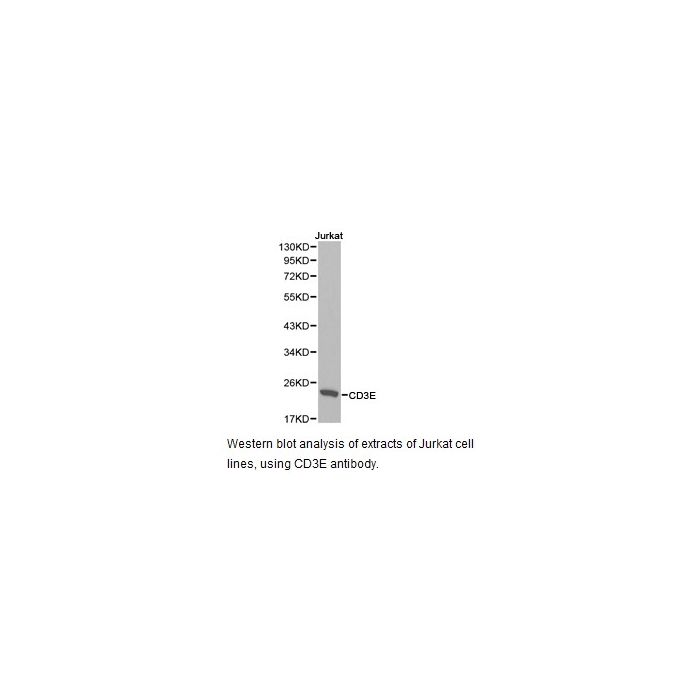CD3-ε polyclonal, anti-human, mouse, rat
€388.00
In stock
SKU
BS6859
Background:
When T cells encounter antigens via the T cell receptor (TCR), information about the quantity and quality of antigens is relayed to the intracellular signal transduction machinery. This activation process depends mainly on CD3 (Cluster of Differentiation 3), a multiunit protein complex that directly associates with the TCR. CD3 is composed of four polypeptides: ζ, γ, ε and δ. Each of these polypeptides contains at least one immunoreceptor tyrosine-based activation motif (ITAM). Engagement of TCR complex with foreign antigens induces tyrosine phosphorylation in the ITAM motifs and phosphorylated ITAMs function as docking sites for signaling molecules such as ZAP-70 and p85 subunit of PI-3 kinase. TCR ligation also induces a conformational change in CD3ε, such that a proline-region is exposed and then associates with the adapter protein Nck.
Alternative Name:
T-cell surface glycoprotein CD3 epsilon chain, T-cell surface antigen T3/Leu-4 epsilon chain, CD_antigen=CD3e, CD3E, T3E
Application Dilution: WB: 1:500~1:2000, IHC: 1:50~1:200
Specificity: CD3-ε polyclonal antibody detects endogenous levels of CD3-ε protein.
Immunogen:
Recombinant full length Human CD3-ε.
MW: ~ 21 kDa
Swis Prot.: P07766
Purification & Purity:
The antibody was affinity-purified from rabbit antiserum by affinity-chromatography using epitope-specific immunogen and the purity is > 95% (by SDS-PAGE).
Format:
1 mg/ml in Phosphate buffered saline (PBS) with 0.05% sodium azide, approx. pH 7.2.
Storage:
Store at 4°C short term. Aliquot and store at -20°C long term. Avoid freeze-thaw cycles.
For research use only, not for use in diagnostic procedure.
When T cells encounter antigens via the T cell receptor (TCR), information about the quantity and quality of antigens is relayed to the intracellular signal transduction machinery. This activation process depends mainly on CD3 (Cluster of Differentiation 3), a multiunit protein complex that directly associates with the TCR. CD3 is composed of four polypeptides: ζ, γ, ε and δ. Each of these polypeptides contains at least one immunoreceptor tyrosine-based activation motif (ITAM). Engagement of TCR complex with foreign antigens induces tyrosine phosphorylation in the ITAM motifs and phosphorylated ITAMs function as docking sites for signaling molecules such as ZAP-70 and p85 subunit of PI-3 kinase. TCR ligation also induces a conformational change in CD3ε, such that a proline-region is exposed and then associates with the adapter protein Nck.
Alternative Name:
T-cell surface glycoprotein CD3 epsilon chain, T-cell surface antigen T3/Leu-4 epsilon chain, CD_antigen=CD3e, CD3E, T3E
Application Dilution: WB: 1:500~1:2000, IHC: 1:50~1:200
Specificity: CD3-ε polyclonal antibody detects endogenous levels of CD3-ε protein.
Immunogen:
Recombinant full length Human CD3-ε.
MW: ~ 21 kDa
Swis Prot.: P07766
Purification & Purity:
The antibody was affinity-purified from rabbit antiserum by affinity-chromatography using epitope-specific immunogen and the purity is > 95% (by SDS-PAGE).
Format:
1 mg/ml in Phosphate buffered saline (PBS) with 0.05% sodium azide, approx. pH 7.2.
Storage:
Store at 4°C short term. Aliquot and store at -20°C long term. Avoid freeze-thaw cycles.
For research use only, not for use in diagnostic procedure.
| Is Featured? | No |
|---|
Write Your Own Review

